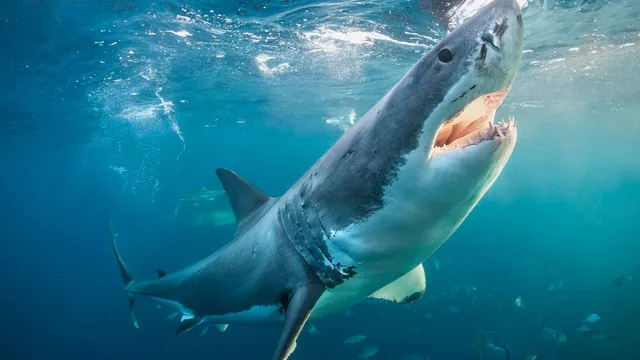
Mysterious gathering of great white sharks baffles scientists
2025-04-26 00:00- The White Shark Café is located midway between Baja California and Hawaii, where hundreds of great whites gather during winter and spring.
- Research has shown that these sharks exhibit prolonged stays in the Café, suggesting feeding and possibly mating activities.
- Continued exploration and studies will likely enhance our understanding of pelagic shark behavior and ecology.
Express your sentiment!
Insights
In the early 2000s, scientists started investigating a unique location in the Pacific Ocean known as the White Shark Café, situated between Baja California and Hawaii. This mid-ocean area has become a site where hundreds of adult great white sharks, primarily males, congregate during winter and spring after feasting on seals and sea lions along the California coast. Despite being in an apparent oceanic desert, research indicates that the sharks may be drawn to this area due to the presence of micronekton and a deep chlorophyll maximum, leading to questions about their behavior in this location. Initially, Barbara Block, a biologist from Stanford University, began tagging great whites in the late 1990s, which revealed their offshore migration patterns. Further research found that these sharks lingered in the Café for months, indicating that their purpose may not solely be for feeding. The National Oceanic and Atmospheric Administration's (NOAA) Office of Ocean Exploration joined the research efforts in 2018, employing advanced technology such as remotely operated vehicles and saildrones to explore the underwater environment and gathering detailed data about oceanographic conditions. The collaborative work of scientists from multiple institutions has yielded significant insights into the survival capabilities of great white sharks. These sharks possess remarkable adaptability due to their ability to maintain body heat in cold waters, which enhances their predatory skills and longevity. They have been found to have genetic traits linked to wound repair and resilience, contributing to their role as apex predators within marine ecosystems. Though advancements in knowledge have been made, many questions remain unanswered about the ecological importance of the White Shark Café. Understanding the mysteries surrounding this unique gathering place may reshape the overall perception of pelagic shark behaviors, especially regarding feeding patterns and potential mating activities among great white sharks in this enigmatic area.
Contexts
The great white shark (Carcharodon carcharias) is one of the most recognizable and studied species of shark, famed for its size and predatory behavior. Found in coastal and offshore waters of temperate seas, these sharks can grow to lengths of over 20 feet and weigh over 5,000 pounds. Their iconic dorsal fin and powerful jaws equipped with numerous serrated teeth make them formidable hunters. Great whites have a unique physiological trait that allows them to maintain a body temperature higher than the surrounding water, which aids in their ability to hunt effectively. Their acute senses, particularly their acute sense of smell, enable them to detect prey from great distances, often leading them to seals, which constitute a significant portion of their diet. This apex predator plays a crucial role in marine ecosystems, helping to maintain the balance of marine life populations. The behavior of great white sharks can be categorized into several distinct patterns, including foraging, mating, and social interactions. They are known to exhibit a hunting technique called 'breaching,' where they launch themselves out of the water to catch seals off guard. Additionally, great whites are known to display migratory behavior, often traveling considerable distances in search of food and optimal breeding grounds. Mating is poorly understood due to the elusive nature of the species; however, it is believed they may have mating rituals that involve physical displays and social interactions. These sharks are also known to engage in solitary behavior, though some individuals may come together in groups, particularly in areas with abundant prey. In terms of social structure, great white sharks demonstrate a fascinating mix of solitary and social behaviors. While generally thought of as solitary predators, research has shown that they can exhibit social behaviors, such as engaging in coordinated hunting or feeding frenzies, particularly when large schools of prey are present. There is also evidence suggesting that young sharks may learn foraging skills from more experienced individuals, highlighting the presence of a social learning aspect within their behavior. Furthermore, great white sharks have been observed exhibiting different behaviors based on environmental factors, such as changes in water temperature or the presence of other predators, indicating their adaptability in varying oceanic conditions. Understanding the behavior of great white sharks is essential not only for conservation efforts but also for managing human-shark interactions. Despite their reputation as dangerous predators, instances of unprovoked attacks on humans are relatively rare and often result from curiosity rather than aggression. Conservation efforts are increasingly focused on protecting great white sharks due to threats from overfishing, habitat destruction, and the shark fin trade. Public awareness campaigns and research initiatives are crucial for fostering a deeper understanding of these magnificent creatures and ensuring their survival in the wild. As key indicators of ocean health, the preservation of great white sharks will contribute to the overall well-being of marine ecosystems.